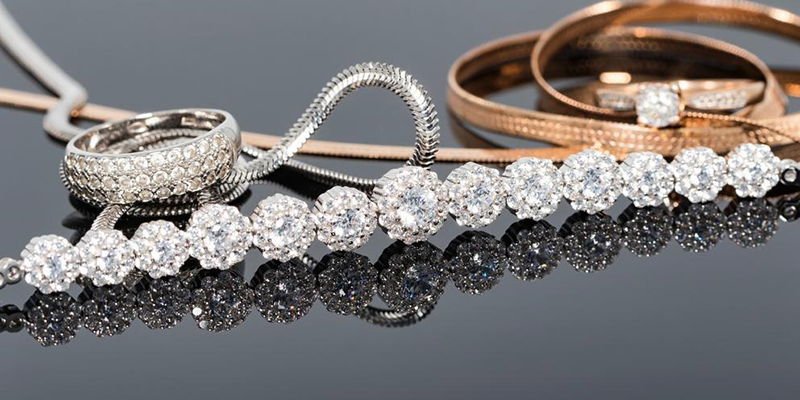
Across centuries and cultures, jewelry has endured as one of the oldest archaeological artifacts, serving to signify social status, preserve wealth, and convey personal meaning.
In the modern era, owning designer jewelry collections, engagement and wedding rings, and cherished antique heirlooms are ordinary. However, whether it’s a luxury Rolex watch, a sentimental engagement ring, or authentic earrings passed down from grandma, it’s crucial to have insurance coverage to protect the value of your precious jewelry pieces.
Why Insure Jewelry?
Most homeowners’ and renters’ insurance policies typically cover jewelry, but they often come with exclusions and limits on coverage. Basic policies might have limits as low as $1,500. While theft is usually covered, damage or accidental loss may not be included.
Adding a jewelry rider or opting for a specialty jewelry insurance policy can provide additional protection. This coverage is typically more comprehensive and often ensures the replacement value of your jewelry. An appraisal may be required to determine the value accurately.
Moreover, jewelry insurance frequently includes coverage for “disappearances,” referring to losses where the timeline cannot be reconstructed, along with worldwide travel coverage for loss or damage. This means that if you misplace your diamond earring while swimming in the ocean in Bora Bora, a specialized jewelry policy will spare you from the heartache of losing it.
How to Protect Jewelry
Even with a jewelry policy in effect, it’s crucial to take measures to keep your items secure:
Store them securely. Storing jewelry in a home safe might seem more secure than placing it in a sock drawer, but many retail safes may not provide adequate security. Lightweight safes can be easily lifted by thieves and removed from the premises. Instead, opt for a heavy, well-constructed safe that is bolted into the wall or floor, preferably in a concealed location on a lower level of the home. Investing in a high-quality safe can be invaluable for the protection it provides, potentially outweighing the value of your precious items.
Take precautions when traveling. When traveling, it’s important to evaluate the hotel room safe before storing items in it. While the safest option for jewelry when traveling is to leave it at home, if the room safe doesn’t seem sufficiently secure, consider asking hotel staff to store your items in the hotel’s master safe.
Regular upkeep is key. Certainly, jewelry is meant to be worn and enjoyed rather than kept locked away. However, before adorning yourself with your favorite pieces, take a moment to inspect them. Ensure that the clasps are functioning properly and that prongs are securely holding stones in place. It’s important to confirm that the jewelry is sturdy and unlikely to break or fall off while you’re out and about. This precaution is especially crucial for older, antique pieces or cherished heirlooms that have been passed down through generations.
Don’t flaunt it. Maintaining discretion about the authenticity and value of your jewelry can be beneficial, especially while traveling. Avoid transporting items in branded containers, such as the iconic Tiffany & Co. blue box, which may attract unwanted attention. When seeking repairs or alterations for your jewelry, consider returning it to the jeweler from whom it was purchased. This limits the number of people who are aware of the piece and helps maintain its confidentiality.
Keep appraisals up to date. Experiencing a loss of jewelry is already distressing, but receiving inadequate compensation for it can compound the frustration. Specialty insurers often provide coverage for jewelry up to 150% of its appraised value. To ensure your jewelry is adequately covered, it’s essential to have it appraised by a professional to determine its accurate value.
Stay on top of jewelry inflation. To address inflation and ensure accurate valuation, it’s recommended to update jewelry appraisals every three to five years. These appraisals should be carried out and confirmed by a certified professional. Additionally, it’s crucial to retain documentation verifying authenticity, along with photos and any relevant receipts. This documentation helps ensure proper valuation and facilitates the claims process in case of loss or damage.
Jewelry insurance isn’t one and done. Regularly reassessing your jewelry insurance policy is essential. Annually, conduct an inventory of all your jewelry pieces. Subsequently, reach out to your insurance agent at Clyde Paul to schedule a policy review. This ensures that your coverage aligns with the current value of your jewelry collection and any changes in your circumstances.
It’s crucial to prioritize both wearing and storing jewelry in the safest manner possible. Discussing your options for loss protection with your insurance agent is essential. Opting for coverage that offers full replacement of your jewelry set in the event of a loss ensures that you can maintain your stunning look without worry.
This content is for informational purposes only and not for the purpose of providing professional, financial, medical or legal advice. You should contact your licensed professional to obtain advice with respect to any particular issue or problem.
